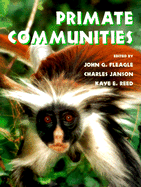Book contents
- Frontmatter
- Contents
- List of contributors
- Preface
- 1 African primate communities: Determinants of structure and threats to survival
- 2 Biomass and use of resources in south and south-east Asian primate communities
- 3 Species coexistence, distribution, and environmental determinants of neotropical primate richness: A community-level zoogeographic analysis
- 4 Primate communities: Madagascar
- 5 Primate diversity
- 6 Phylogenetic and temporal perspectives on primate ecology
- 7 Population density of primates in communities: Differences in community structure
- 8 Body mass, competition and the structure of primate communities
- 9 Convergence and divergence in primate social systems
- 10 Of mice and monkeys: Primates as predictors of mammal community richness
- 11 Comparing communities
- 12 Large-scale patterns of species richness and species range size in anthropoid primates
- 13 The recent evolutionary past of primate communities: Likely environmental impacts during the past three millennia
- 14 Resources and primate community structure
- 15 Effects of subsistence hunting and forest types on the structure of Amazonian primate communities
- 16 Spatial and temporal scales in primate community structure
- 17 Primate communities in Africa: The consequences of long-term evolution or the artifact of recent hunting?
- 18 The future of primate communities: A reflection of the present?
- 19 Concluding remarks
- Systematic index
- Subject index
4 - Primate communities: Madagascar
Published online by Cambridge University Press: 21 August 2009
- Frontmatter
- Contents
- List of contributors
- Preface
- 1 African primate communities: Determinants of structure and threats to survival
- 2 Biomass and use of resources in south and south-east Asian primate communities
- 3 Species coexistence, distribution, and environmental determinants of neotropical primate richness: A community-level zoogeographic analysis
- 4 Primate communities: Madagascar
- 5 Primate diversity
- 6 Phylogenetic and temporal perspectives on primate ecology
- 7 Population density of primates in communities: Differences in community structure
- 8 Body mass, competition and the structure of primate communities
- 9 Convergence and divergence in primate social systems
- 10 Of mice and monkeys: Primates as predictors of mammal community richness
- 11 Comparing communities
- 12 Large-scale patterns of species richness and species range size in anthropoid primates
- 13 The recent evolutionary past of primate communities: Likely environmental impacts during the past three millennia
- 14 Resources and primate community structure
- 15 Effects of subsistence hunting and forest types on the structure of Amazonian primate communities
- 16 Spatial and temporal scales in primate community structure
- 17 Primate communities in Africa: The consequences of long-term evolution or the artifact of recent hunting?
- 18 The future of primate communities: A reflection of the present?
- 19 Concluding remarks
- Systematic index
- Subject index
Summary
INTRODUCTION
Madagascar, “La Grande Ile” off the coast of south-east Africa, is the fourth largest island on earth. Its 587000 km2 are topped only by the islands of Greenland, New Guinea and Borneo. The island broke off from Africa some 150 to 160 million and from India some 88 to 95 million years ago. Although Madagascar is separated from Africa only by the Mozambique Channel, no more than about 300 to 450 km wide, the prevailing winds and ocean currents were and still are unfavorable for repeated colonization of the island (Krause et al., 1997). Due to the long isolation and low rate of colonization events, the flora and fauna of Madagascar underwent impressive adaptive radiations, resulting in one of the world's most diverse arrays of endemic plants and animals (Myers, 1986; Mittermeier, 1988; Table 4.1).
Based on phytogeographic criteria, the evergreen forests of eastern Madagascar are distinguished from the deciduous formations of the west and south (Du Puy & Moat, 1996; Lowry et al., 1997; Fig. 4.1). The evergreen rainforests of the east receive between 1500 and more than 3000 mm of rain per year. The deciduous forests of the west and extreme north of Madagascar are subject to a distinct dry season of four to eight months without rain and annual precipitation of 500 to 2000 mm. In both vegetation types, annual rainfall decreases from the north to the south. Parts of the south and south-west of the island receive less than 500 mm of rain per year at irregular intervals with an extended dry season for more than eight months. Here, habitats are represented by dry deciduous, riverine and spiny forest characterized by Didieraceae and other succulent plants.
- Type
- Chapter
- Information
- Primate Communities , pp. 75 - 89Publisher: Cambridge University PressPrint publication year: 1999
- 64
- Cited by

